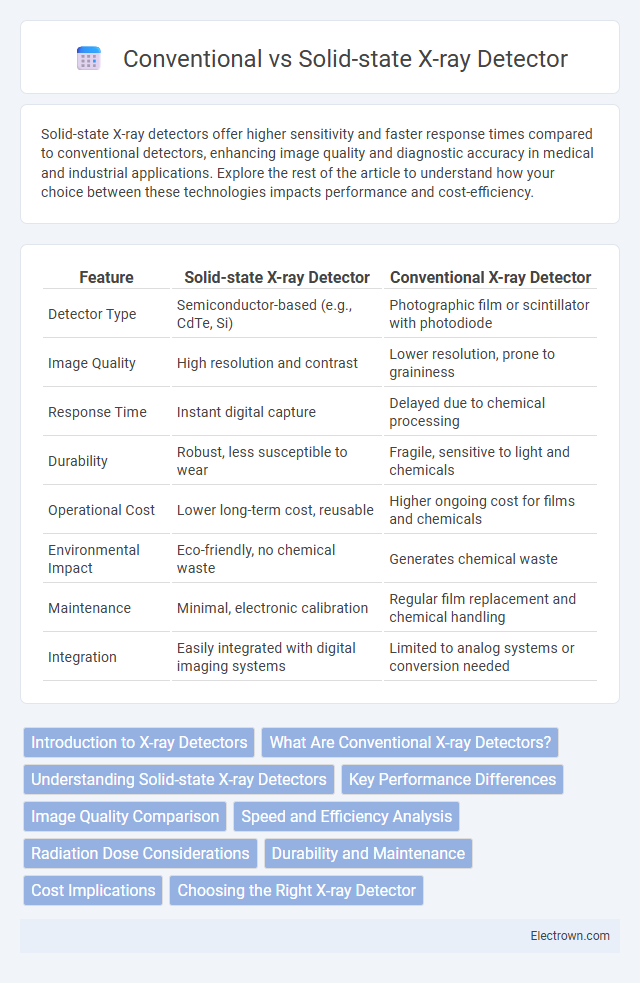Solid-state X-ray detectors offer higher sensitivity and faster response times compared to conventional detectors, enhancing image quality and diagnostic accuracy in medical and industrial applications. Explore the rest of the article to understand how your choice between these technologies impacts performance and cost-efficiency.
Table of Comparison
| Feature | Solid-state X-ray Detector | Conventional X-ray Detector |
|---|---|---|
| Detector Type | Semiconductor-based (e.g., CdTe, Si) | Photographic film or scintillator with photodiode |
| Image Quality | High resolution and contrast | Lower resolution, prone to graininess |
| Response Time | Instant digital capture | Delayed due to chemical processing |
| Durability | Robust, less susceptible to wear | Fragile, sensitive to light and chemicals |
| Operational Cost | Lower long-term cost, reusable | Higher ongoing cost for films and chemicals |
| Environmental Impact | Eco-friendly, no chemical waste | Generates chemical waste |
| Maintenance | Minimal, electronic calibration | Regular film replacement and chemical handling |
| Integration | Easily integrated with digital imaging systems | Limited to analog systems or conversion needed |
Introduction to X-ray Detectors
X-ray detectors are critical components in medical imaging, industrial inspection, and security screening, designed to capture and convert X-ray photons into measurable signals. Solid-state detectors use semiconductor materials such as silicon or cadmium telluride to directly convert X-rays into electrical signals with high spatial resolution and efficiency. Conventional detectors, including scintillator coupled photodiodes or film-based systems, rely on indirect conversion processes, often resulting in lower sensitivity and slower response times compared to solid-state alternatives.
What Are Conventional X-ray Detectors?
Conventional X-ray detectors primarily consist of photochemical film and photostimulable phosphor plates that capture X-ray images through indirect exposure and processing. These detectors rely on physical or chemical reactions to visualize the X-ray patterns, requiring time-consuming development steps before image analysis. While widely used, conventional detectors exhibit limitations in spatial resolution, dynamic range, and image acquisition speed compared to solid-state detectors.
Understanding Solid-state X-ray Detectors
Solid-state X-ray detectors use semiconductor materials like silicon or cadmium telluride to directly convert X-ray photons into electrical signals, offering higher resolution and faster image processing compared to conventional detectors. Unlike conventional scintillator-based detectors that rely on light conversion, solid-state detectors provide enhanced sensitivity and reduced noise, improving diagnostic accuracy in medical imaging and industrial inspections. Understanding these advantages helps you choose the right technology for precise and efficient X-ray detection applications.
Key Performance Differences
Solid-state X-ray detectors offer higher spatial resolution and faster image acquisition compared to conventional detectors, which often rely on scintillators and photodiodes. The enhanced sensitivity of solid-state detectors results in lower radiation doses needed for clear imaging, improving patient safety. Conventional detectors typically exhibit slower response times and lower durability due to their mechanical components, whereas solid-state technology provides more consistent performance and longer operational life.
Image Quality Comparison
Solid-state X-ray detectors generally provide superior image quality compared to conventional detectors due to higher spatial resolution and enhanced signal-to-noise ratio. Solid-state detectors use direct conversion materials like amorphous selenium, minimizing image distortion and improving edge definition. Your diagnostic accuracy benefits from clearer images with greater detail and reduced artifacts, crucial for precise medical evaluations.
Speed and Efficiency Analysis
Solid-state X-ray detectors offer significantly faster readout speeds compared to conventional detectors, enabling real-time imaging with minimal lag. Their higher quantum efficiency enhances signal-to-noise ratio, resulting in improved image quality at lower radiation doses. Conventional detectors, often based on scintillator and photodiode combinations, exhibit slower response times and reduced efficiency due to light conversion losses and noise factors.
Radiation Dose Considerations
Solid-state X-ray detectors typically require lower radiation doses compared to conventional detectors due to their higher sensitivity and improved signal-to-noise ratio, enhancing patient safety by minimizing exposure. Conventional detectors often rely on scintillators and photodiode arrays, which may necessitate higher doses to achieve comparable image quality. Optimizing radiation dose with solid-state technology supports better diagnostic accuracy while adhering to the ALARA (As Low As Reasonably Achievable) principle in radiographic imaging.
Durability and Maintenance
Solid-state X-ray detectors offer superior durability due to their robust construction and resistance to mechanical shock and environmental factors, significantly reducing the need for frequent maintenance compared to conventional detectors. Conventional X-ray detectors often contain fragile components like photomultiplier tubes that require regular calibration and replacement, increasing downtime and operational costs. The maintenance efficiency and longer lifespan of solid-state detectors make them more reliable for continuous use in demanding medical and industrial imaging environments.
Cost Implications
Solid-state X-ray detectors generally incur higher upfront costs due to advanced semiconductor materials like silicon or cadmium telluride, but offer lower maintenance expenses and longer lifespan compared to conventional detectors that use photostimulable phosphor plates or film. Conventional X-ray detectors have lower initial investment but involve recurring costs related to film processing chemicals, storage, and manual handling. Overall, solid-state detectors deliver cost efficiency over time by reducing consumables and improving workflow speed in medical and industrial imaging applications.
Choosing the Right X-ray Detector
Selecting the right X-ray detector depends on the specific application requirements, such as resolution, sensitivity, and speed. Solid-state detectors offer higher spatial resolution, faster image acquisition, and better energy discrimination compared to conventional scintillator-photodiode systems. Conventional X-ray detectors, while generally more affordable and robust, may lack the advanced imaging capabilities and lower noise levels provided by solid-state technologies, making them less suitable for high-precision diagnostic or industrial tasks.
Solid-state vs Conventional X-ray Detector Infographic

 electrown.com
electrown.com